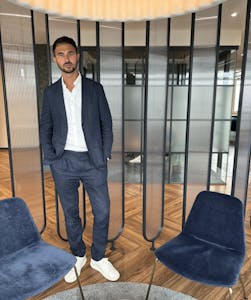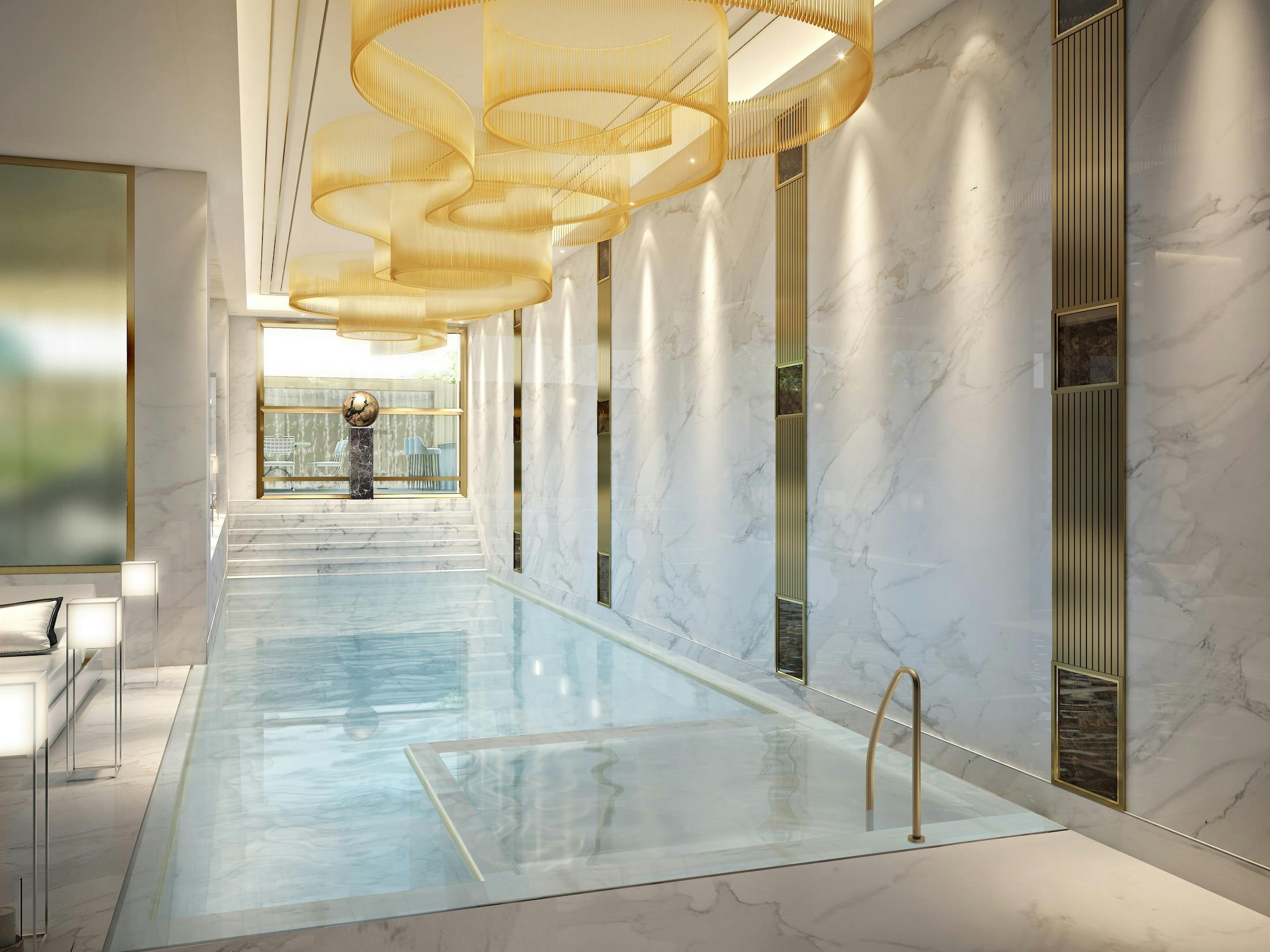Created by former Country Life Editor Sandy Mitchell, design, project management and construction consultancy RedBook has been helping high net worth homeowners realise their property ambitions since 2007. The team has overseen everything from stately home restorations and townhouse reinventions, to cutting-edge contemporary new-builds and super-prime penthouse revamps.
Tom Adams was installed as CEO in 2020, embarking on an ambitious growth plan that has seen the business evolve into a wide-reaching staple of the luxury property sphere. “Our goal is for RedBook to be the premier destination for design and delivery talent,” he says in conversation with PrimeResi, as he shares future plans, highlights key trends, and flags challenges for HNW clients looking to transform a property.

You’ve made some substantial changes to RedBook since joining as CEO four years ago, including bringing in some heavyweight directors and advisors, adding new services, and pledging carbon neutrality. What is your vision for the business in the coming years?

I want to change the way people approach projects, pushing for a complete shift of mindset. There is a better, faster, and more reliable way of undertaking a property project, and I truly believe RedBook is uniquely positioned to deliver that.
While that’s been the case since the company launched, we’ve evolved from our original role of project team assembly to becoming fully-fledged ‘Project Directors’ with the capacity to deliver, these often, highly complex prime/super prime projects over the finish line. To achieve this, we now offer a range of client services that begin with the original team assembly stage. We are not Project Managers and have no intention to be and continue to work with PM’s on most projects. But should clients wish, we can also provide them with a RedBook Project Guardian who acts as a hands-on advisor to guide them through the many strategic decisions that need to be made once the team has been given the green light. For very significant projects, we are also offering a third level of engagement in the form of a RedBook ‘Client Representative’ who will be able to stand in place of the client and have the capacity to move the project forward on their behalf.
All of this means that RedBook now offers a game-changing value proposition. Our rigorous vetting and due diligence processes ensure clients are guided through the entire project journey, matched with the perfect team tailored to their tastes and needs.
Expanding globally, I’m committed to introducing this mindset to other real estate hotspots such as the Middle East, the south of France, and the States over the coming years. Our goal is for RedBook to be the premier destination for design and delivery talent. Regardless of where you are in the world, our mission remains the same: to empower clients with access to the best-suited teams for their projects (from planning consultants to contractors), whilst mitigating risk and delivering a streamlined and hopefully stress-free experience.
Our goal is for RedBook to be the premier destination for design and delivery talent

RedBook is soon roll out a new “FastTrack” service for clients. How does this differ from the standard RedBook offering?
This is an industry first. FastTrack is a premium service for high-value homeowners who want their projects completed with the utmost speed, without compromising on quality and service. Using over 40 time-saving techniques and more than 25 risk mitigation strategies pooled from our experience of advising clients on more than 300 projects in the past decade and the expertise of some of our most dynamic Partners, FastTrack cuts the length of a significant property project by as much as 30%. The techniques outlined in our bespoke FastTrack ‘PlayBook’ shave time off every project stage, from pre-purchase to final handover. It’s a hugely exciting new offering for our clients. We are excited to unveil it in the near future.
You are also launching a new index of construction costs, professional fees and industry trends; can you tell us about the project?
The RedBook Index on luxury projects is a new, dynamic data platform that will become invaluable to those operating within the world of prime and super prime residential property projects. For the first time ever, it consolidates market construction costs, professional fees and industry trends in the luxury sphere. Updated annually, it will track evolving patterns and forecast future trends based on a comprehensive, data pool drawn from over 1,000 live projects.
To make this possible, we’ve leveraged our position working closely with over 200 top-tier design and delivery firms across the UK. Covering a range of scopes from new builds to refurbishments, redecorations and FF&E, as well as comparing London vs Country and listed versus non-listed buildings. This index provides unique intelligence into project costing that can act as an industry benchmark for clients and professional advisors. It will also cover areas such as planning and key design trends to provide a rounded and fascinating insight into the ever-changing landscape of luxury projects.
We’re excited about the potential impact of the Index and look forward to its continued development not only within the UK but also on an international scale. It will be launched this Autumn.
Building costs rocketed through the pandemic years, and more recently wider inflation has made everything more expensive. Are construction costs still climbing, and what’s your advice to clients trying to budget a large project now?
Construction costs have stabilised following a period of significant inflation over the past few years, driven by the obvious factors of the energy crisis, disruptions in material supply due to the conflict in Ukraine, and labour shortages resulting from the combined effects of the pandemic and Brexit.
For clients embarking on large projects, it’s crucial to recognise the additional expenses beyond material costs. Factors such as contractor overheads, profits & preliminary work costs (averaging around a combined 23%), and professional fees (often exceeding 20%) need to be factored before commencing. Considerations like FF&E, VAT and landscaping expenses are often overlooked or underestimated, these can be significant, too.

What are the most common mistakes people make when undertaking a big renovation project?
Property projects – particularly at the top end of the market – are highly complex. We’ve often likened the process to conducting an orchestra. The operation requires coordination of permissions (planning and otherwise), people, materials and machinery, along with many other moving parts. To succeed, it also needs to be on standby for, as yet, unknown obstacles from incomplete design information to the sudden realisation that a protected species of bat resides in the roof rafters or coming across highly complicated party wall matters.
The most common hurdles include having too many voices in the mix, failing to budget correctly, and establishing unrealistic time frames. RedBook avoids these through a clear single point of contact that strategically orders matters of priority to avoid jumping the gun and then losing time having to backtrack. It’s our job to organise who needs to be commissioned and when, in line with the project brief aspirations, timescale, and budget.
The most common hurdles include having too many voices in the mix, failing to budget correctly and establishing unrealistic time frames

How high is energy efficiency and retrofitting on RedBook clients’ agendas, and how do you deal with the particular challenges of improving sustainability credentials for period homes?
The appetite varies from client to client. What we have noticed is that these questions tend to be more significant for younger owners and less so for older demographics. However, at RedBook, we make it a priority to try and educate all our clients on the benefits of sustainable projects.
When joining RedBook, I made it a priority to develop our Green Agenda, which has now become central to our business ethos. This involved introducing sustainability consultants, “green” designers, carbon offsetting initiatives, and significant tree planting efforts. We advise clients on approaching projects through a sustainability lens, representing a range of green consultants and firms who are leaders in sustainable design.
Taking this a step further, we go to great lengths to ensure that all our clients’ projects are carbon-neutral, covering the associated costs ourselves. To facilitate this, we’ve developed a tool to calculate the projected CO2 output of our client’s property projects and offset the impact generated by each of our partners, such as architects and contractors. While it’s not a complete solution, it allows us to do our bit in the here and now.
We go to great lengths to ensure that all our clients’ projects are carbon neutral, covering the associated costs ourselves
Have high-net-worth individuals’ design tastes changed much since RedBook was founded by Sandy Mitchell in 2010, and are there any emerging design trends that you are noticing now?
With a growing international clientele and broader demographic, design tastes have become significantly more diverse. It has been a pleasure for the team and me to expand RedBook’s roster of talent within our Partners to meet this wide-ranging demand.
One noticeable international trend in the Middle East is the departure from a traditional, more ornate style towards a more contemporary and eclectic aesthetic, that whilst cleaner and modern is still richly layered.
Many of our clients own multiple homes globally and want each residence to have a unique sense of place reflecting the local area, with integrated fuss-free technology. We’re seeing a shift from big-name brands toward more understated, minimalist luxury using high-quality, locally sourced materials and artisans.
We’re seeing a shift from big-name brands toward more understated, minimalist luxury

What are the biggest challenges facing the design and construction sectors right now?
To date, the lack of government resources to process planning applications has had a huge impact on project timelines. It remains to be seen whether the new government will address this swiftly – but the rhetoric and intent seems to be there. It’s anticipated that some regulatory changes will be coming down the pipeline which could also impact project costs and timelines.
The demand for skilled professionals, particularly architects, continues to rise, yet retaining them can prove challenging. The arduous journey of acquiring architectural qualifications, typically spanning seven years of rigorous study and apprenticeship, presents a considerable commitment. With advancements in technology and changes in societal expectations, the traditional pathways to professional fulfilment may no longer align with the aspirations of emerging professionals.
The new government has just unveiled a suite of reforms to the planning system in a bid to promote house building and residential development. Do you think these changes will affect RedBook clients?
So far, the Government’s aims are focussing on boosting housebuilding, in particular increasing the number of social and affordable homes put up for sale. The reforms of the planning system look to open up opportunities for new developments on the outskirts of towns – the so-called “grey belt” zones – which we don’t believe will impact our clients’ plans so far. However, we sense a willingness from local authorities to meet the demands by seeking to hire more planning officers, and clients can potentially play a role in providing much-needed capital to fund resources through brokering a planning performance agreement with a local authority to guarantee timescales and open lines of direct communication. So, we’re keeping a constant eye on the evolving landscape and ways in which it can benefit our clients.
Discretion is clearly a big part of the service, but are there any stand-out recent RedBook projects that you can tell us about?
Discretion is such a fundamental aspect of our service that we are, alas, unable to disclose specific project information.
That said, I’m excited to share a glimpse into our current portfolio of over 60 live projects, including a 30,000 sq ft Grade I Listed country estate, two 25,000+ sq ft new-build country houses, also two penthouses within two of London’s super-prime schemes and a collection of prestigious properties in both Saudi Arabia, Dubai and the South of France.

What are some of the more “out-there” requests you have received – and delivered – for your clients to date?
Client requests for extraordinary home features are continually pushing boundaries. We recently designed a bespoke sneaker room for a client’s collection of 5,000 pairs of trainers as part of a London townhouse project. This challenge inspired the design team to create an immersive space incorporating custom storage, glass display cases, interactive elements, and curated artwork. We’ve also noticed a trend towards wellness-focused pool complexes, with ice plunge pools and saunas replacing traditional swimming pools.
We recently designed a bespoke sneaker room for a client’s collection of 5,000 pairs of trainers as part of a London townhouse project

We hear that every member of the RedBook team has undertaken a property project on their own home; is this a coincidence or a conscious recruitment decision?
This is a conscious choice in our recruitment process. We believe firsthand experience with property projects is essential for understanding their complexities, and clients value this expertise. All our Project Guardians and most of the senior team are architecturally trained as well, which is a key hiring consideration.
Your background is in founding a business in country sports as well as property; are there any insights from outside the property world that you have found particularly useful?
My experience in developing an index for a different industry informed my vision for creating The RedBook Index. I didn’t come from a design background originally but my extensive experience with high-net-worth and ultra-high-net-worth clients has given me a very client-centric view. This unique perspective allows me to identify efficiencies and drive developments in ways that may differ from a team solely composed of designers. Ultimately, this diversity of experience enriches our approach and enhances our ability to serve our clients effectively.
What’s the best piece of advice you have ever been given?

It came from the Chairman of my previous business: he believed (and instilled in me) that quality should always prevail over quantity. By focusing on quality, quantity naturally follows.
By focusing on quality, quantity naturally follows
Contact Book
- Tom Adams
- CEO, RedBook
- 020 7060 6222
- [email protected]
- redbookagency.com
All images via Redbook


